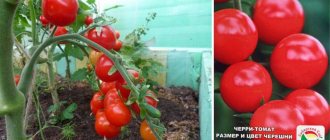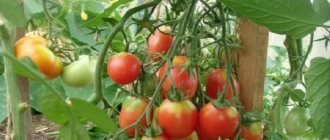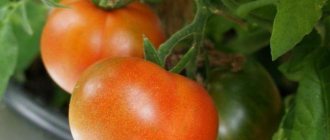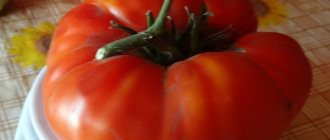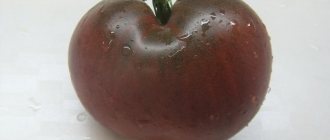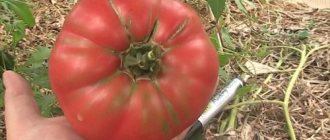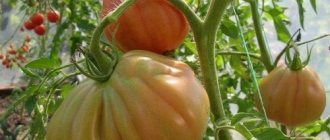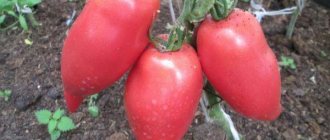The Polar early ripening tomato will appeal to summer residents of cold regions, where tomatoes are traditionally planted in greenhouses. It can grow in open ground, bears fruit well, and its classic tomato taste will complement any vegetable dish.
| Height | Landing location | Ripening time | Fruit color | Fruit size | Origin | Fruit shape |
| short | Greenhouse, Open ground | Ultra early | Reds | Average | Variety | Round |
Description and characteristics of the variety
Polar early ripening tomato bushes of determinate type, with an average height of 40 cm, a maximum of 70 cm. The first inflorescence develops above the 7th leaf, and the interval between the next ones is two leaves each. The variety is considered ultra-early, the first harvest is harvested 99-105 days after planting. The fruits are round or flat-round, resembling apples. Their color at maturity is red, the average size is 60-100 g, but with careful care and feeding you can get tomatoes weighing 150-160 g. Inside there are 7-12 seed chambers and about 7% dry matter.
The taste is ordinary tomato, has a sourness. The use is universal: you can preserve and pickle fruits, cook dishes and eat them fresh.
Advantages and disadvantages
Long-term cultivation of tomatoes of this variety suggests that it is competitive and is not inferior in quality to varieties that were bred much later.
The main advantages of the Polar early ripening tomato include:
- high yield, which reaches 1.5 kg. When planting 6-7 bushes per m2, the yield can reach up to 10 kg;
- the ability of picked fruits to “reach” the required degree of ripening, being picked in milky ripeness;
- friendly harvest yield:
- resistance to temperature changes and cold snaps. This makes it possible for this variety to be used in regions with cold climates not only in greenhouses, but also in open ground;
- versatility of the fruit. They are good both fresh and for processing;
- Thanks to the rapid ripening, the fruits can be quickly collected and processed. This variety is excellent both in pickled or canned form, and for making juices and purees;
- Resistance to diseases such as brown spot and tobacco mosaic makes this variety very attractive to tomato lovers.
The disadvantages of the variety include:
- unevenness of fruit in weight and shape;
- lack of competitiveness compared to new hybrids;
- poor responsiveness to new agricultural practices.
Secrets of successful cultivation of the variety
- To maintain high yields and to avoid thickening of the bush, the removal of stepsons is required.
- For cultivation in the southern regions, it is desirable to place them in the shade and away from taller and leafier tomatoes. Under the direct rays of the scorching sun, the tomato will quickly begin to age.
- Before planting, it is advisable for the seeds to undergo stratification at a temperature of 0 -2C degrees. It consists of placing the seeds in the refrigerator or taking them outside, where they are hardened during the day.
- When planting without seedlings, it is strongly recommended to grow tomatoes under a covering material (agrofibre, spunbond, lutrasil). You can remove the cover when the threat of frost has passed and the plants have become stronger.
- Scheme: planting 35x50 cm, number of plants 6-9 pcs. per sq. meter.
- Despite the resistance of tomatoes to various negative factors, it is advisable to carry out 1-2 preventive treatments against diseases and pests.
- Adding organic matter to the soil and regularly providing macro- and microelements in the quantities required for tomatoes.
Despite all the advantages, the variety, unfortunately, is inferior to new hybrids in many respects.
tomato Purple candle - description and characteristics of the variety
Strengths of the variety
- Stable fruiting in a number of unfavorable weather conditions, during dry or, on the contrary, rainy periods.
- Liberalism in agricultural technology and unpretentiousness in growing conditions.
- They can withstand short periods of cold weather.
- The ability to set fruit in stressful situations.
- Good yield throughout the season, 4-5 kg per 1 kg/sq.m.
- Along with competent agricultural technology and in protected soil conditions, Polar early ripening is able to almost double the yield indicators - up to 7-8 kg/sq.m.
- High fertility when grown both by seedlings and without seedlings.
- The first fruit inflorescence is formed after the growth of 7 leaves, subsequent clusters every 2.
- Excellent shelf life and transportability, suitable for transportation over long distances.
- The fruits have a good tendency to ripen. Tomatoes picked while still green can be kept for up to a month under suitable conditions.
- Resistance to diseases, in particular to the tobacco mosaic virus, and in turn brown spot.
Early ripening Siberian tomato: variety description
| Variety name | Siberian early ripening |
| general description | Early ripening determinate variety |
| Originator | Russia |
| Ripening period | 115-130 days |
| Form | Flat-round slightly ribbed |
| Color | Red |
| Average weight of tomatoes | 60-110 grams |
| Application | Universal |
| Productivity of the variety | 9-10 kg per sq.m |
| Features of cultivation | Standard agricultural technology |
| Disease resistance | Prevention of certain diseases is required |
According to the type of growth of the bush, this species belongs to the determinate varieties of tomatoes. The height of its bushes can range from thirty to ninety-four centimeters. The stem is characterized by strong foliage. The leaves are medium in size and green or dark green in color. Does not form a standard.
Siberian early ripening is usually classified as an early ripening variety, since from the appearance of the first shoots to the ripening of the fruits, it takes from one hundred fifteen to one hundred thirty days. It is resistant to brown spot and tobacco mosaic virus, and is moderately resistant to other diseases. Tomatoes of this variety can be grown both in a greenhouse and in open ground.
The main advantages of the Siberian early ripening tomato variety are:
- Good yield;
- Cold resistance;
- The versatility of fruits in use;
- Unpretentiousness;
- Long fruiting period;
- Resistance to certain diseases.
Vegetable growers call the disadvantages of “Siberian early ripening”:
- Obsolescence.
- Inability to compete with modern hybrid varieties for many characteristics.
As you can see, these shortcomings are very subjective.
Description of fruits and yield
The Siberian Troika tomato, the characteristics and description of the variety of which are presented in this article, has large fruits. Its yield is much higher than that of other large-fruited varieties. The Siberian Troika tomato variety can be grown in greenhouses, but in open ground it brings greater yield. The seeds produce strong seedlings. Moreover, even in low light, it does not stretch.
Effective, convenient and sooooo fast. When you need to lose 3-4 kilograms in a week. More details here.
The Siberian Troika tomato variety was bred by Siberian breeders in 2004. The new variety quickly gained popularity among gardeners and spread throughout all corners of the country. The main feature of the Siberian Troika is the high yield among varieties with large fruits.
- Variety, not hybrid.
- Large-fruited.
- Determinate, stops growing on its own. The plant grows up to 50 cm in height.
- Standard bush.
- A plant with a powerful stem has leaves reminiscent of potatoes and the same lush green color.
- The bushes have a neat shape and a well-developed root system.
- The Siberian Troika tomato is a mid-season variety. After emergence, the fruits begin to ripen in 110–115 days.
Important! You can prepare the seeds of the Siberian Troika yourself from fully ripened tomatoes. As practice has shown, they have excellent germination. During the growing season, the color of tomatoes changes: from brown to bright red.
The shape of the fruit is in the form of a cylinder or pepper, slightly elongated, with a sharp spout at the end
During the growing season, the color of tomatoes changes: from brown to bright red. The shape of the fruit is in the form of a cylinder or pepper, slightly elongated, with a sharp spout at the end
The skin of a tomato is dense but tender, which is important when preparing various dishes. The fruit has good fleshiness and has 3-4 seed chambers inside which there are many seeds. Dry matter - average amount
Ripe fruits grow up to 12 cm in length, and their weight ranges from 150 g to 300 g. Ripe tomatoes can be stored for a long time. Do not crack
Dry substances - average amount. Ripe fruits grow up to 12 cm in length, and their weight ranges from 150 g to 300 g. Ripe tomatoes can be stored for a long time. Do not crack.
Photos of the Siberian Troika tomato variety are presented below.
Thinner Stepanenko: I weighed 108, and now 65. I drank warm water at night. More details here.
- High yield.
- The tomatoes are large, meaty and tasty.
- They are stored for a long time.
- The bushes are compact.
- Resistant to diseases.
This description and characteristics of the Siberian Troika variety is a strong argument in favor of choosing tomatoes.
Important! However, it is worth knowing that to obtain a good harvest, determinate varieties are grown in open ground. And tall (indeterminate) varieties of tomatoes bear fruit better in a greenhouse. Breeders developed the Siberian Troika variety for the northern regions (Siberia, Urals)
However, these tomatoes are grown with success in the south of the country. Here you can plant the seeds directly in open ground. In cold climates it is better to grow this variety using seedlings
Breeders developed the Siberian Troika variety for the northern regions (Siberia, Urals). However, these tomatoes are grown with success in the south of the country. Here you can plant the seeds directly in open ground. In cold climates, it is better to grow this variety using seedlings.
For seedlings, it is necessary to sow the seeds 2 months before transferring them to the ground, approximately at the end of March. In regions with harsh climates, seedlings are recommended to be planted in early June. In greenhouse conditions, this procedure can be carried out at the end of May. In the south, seedlings are planted 15-20 days earlier.
Before you start sowing seeds, they should be disinfected by holding them in a weak solution of potassium permanganate. You need to sow the planting material into the substrate, deepening them 1 cm. If the seeds are sown in a large container, leave a distance of 1.5 cm between them. After 2 good leaves appear, pick them into separate cups.
You can prepare any dish from the Sibirskaya Troika tomato. They are consumed raw, added to salads, on sandwiches, etc. Ripe fruits are rich in vitamin C, lycopene, and other beneficial elements.
An important quality of this crop is that all the beneficial properties of the tomato are preserved even after heat treatment. The fruits have a dense skin and do not crack, which makes it possible to preserve, salt and pickle them. Tomatoes are also used to make juices and pastes.
Characteristics and description of the tomato variety “Skorospelka” with reviews
All summer residents plant tomatoes on their plots; the crop is considered one of the most beloved. Of the many varieties, “Skorospelka” stands out. The fruits are not only tasty, but also healthy. In addition, tomato seedlings can grow at low temperatures
Many summer residents pay attention to early varieties of tomatoes. “Skorospelka” is especially popular. The variety has many advantages
It can be grown both in a greenhouse and in open ground
The variety has many advantages. It can be grown both in a greenhouse and in open ground.
Characteristics and description of the variety
The seedlings are short in stature and have a lot of foliage. Up to 7 fruits are formed on the bush. With proper care of the crop, you can get a good harvest. The “Skorospelka” tomato requires pinching and gartering. Since the variety is early, it has low yield.
You can start harvesting after 85 days. Ripe fruits acquire a bright red color and become flat-round in shape. The weight of the fruit reaches up to 150 grams.
Advantages and disadvantages of the variety
The Skorospelka tomato, like other varieties, has its positive and negative aspects. The advantages include the following:
Among the shortcomings, the following are considered the most significant:
- low yield;
- the need to carry out pinching and tying.
Features of growing and caring for the variety
Tomato "Skorospelka" is grown through seedlings. Seeds should be sown in the second half of March. They need to be prepared before sowing. To do this, planting material must be treated with a growth stimulant and drugs against diseases.
Tomatoes prefer to grow in loose, fertile soil. To simplify the process of growing seedlings, soil can be purchased at a specialty store. In order for the seeds to germinate faster, the soil must be watered with a solution of potassium permanganate.
Planting work will not cause any difficulties. The seeds should be placed in the soil, covered with soil and covered with film. Containers with crops should be placed in a warm place. In a few days the first shoots will appear. After this, the film can be removed and the pots with seedlings can be removed to a bright place.
It is necessary to plant plants in the soil only when the threat of frost has passed.
Tomato care
The variety "Skorospelka" is resistant to diseases and pests. Therefore, crop care is minimal and consists of the following activities:
Loosening the soil. Tomatoes prefer to grow on loose soil
The procedure is important; it allows you to remove the soil crust. Watering
Tomatoes respond well to soil moisture
This is especially true in hot weather. Experienced gardeners additionally recommend using drip irrigation. Feeding. Over the course of the entire season, fertilizing is required several times. Tying. To prevent the stems from breaking, it is necessary to install a support and tie up the plants.
The main purpose of the variety
Tomato fruits are universal. They can be eaten fresh, canned, or used to make tomato juice.
The fruits have good keeping quality and can be transported. Summer residents use the variety both for their own consumption and for sale.
In what regions is it grown?
The variety "Skorospelka" is considered unique; it is grown everywhere. Even in regions with a cool climate you can get a good harvest. The variety can grow in a greenhouse or in open ground.
Growing tomatoes
“Troika” is grown traditionally - through seedlings with subsequent planting in a permanent place. It is advisable to cultivate this variety in open ground, since the yield in a greenhouse can be significantly lower. Tomato is not picky about soil, and its seeds produce good seedlings in the second and subsequent generations.
How to prepare seeds?
On the eve of planting, pre-sowing seed treatment is carried out. This is done to accelerate growth, strengthen immunity and increase germination from the nominal 60 to the desired 90%. Processing includes the following procedures:
- Inspection of seeds to identify those that are not suitable for planting: those that have a loose structure, are empty, have signs of damage, or are not uniformly colored;
- Disinfection in a solution of potassium permanganate or hydrogen peroxide for 20-30 minutes;
- Soaking in purified water for 12 hours so that the seeds can absorb moisture and open. Ideally, secondary defrost melt water should be used. The resulting liquid is poured into the seeds, and an aquarium pump is installed in the same container, saturating the water with oxygen. This treatment is called bubbling. With its help, you can reduce the total ripening time of plants to 5 days.
Early ripening varieties of tomatoes:
Sowing seed material
Sowing of seeds is carried out in the first half of April - 2 months before planting for permanent residence. It is not recommended to sow earlier due to low solar activity: seedlings sown in April, within 45 days, catch up in development with seedlings sown at the end of March.
Store-bought soil is used as a substrate for growing vegetable seedlings. You can prepare the soil yourself. To do this, you need to mix garden turf, peat and sand in a ratio of 2:2:1, add about 10% vermicompost and a small amount of perlite and vermiculite.
A 2-cm layer of drainage (kermazite or charcoal) is poured onto the bottom of the planting container, then the main soil. The seeds are placed in grooves 1.5 cm deep, sprinkled with peat, and watered with warm water. Before sprouts peck, the seedlings are covered with glass or film. After germination, the seedlings are exposed to light. Once every two weeks, seedlings need to be fed with mineral complexes, periodically watered and loosened the soil.
IMPORTANT: Picking is carried out at the stage of formation of the 1st true leaf
Rules for planting seedlings
Plants are planted in open ground in the second half of May. This period is considered the most favorable, since the night temperature does not fall below 15*C, and spring moisture still remains in the ground. By this time, the tomato bushes have stretched up to 25-30 cm, and at least 6 true leaves are formed on each of them.
Before planting, seedlings undergo hardening training for 2 weeks. Plants are placed in a cool room with a temperature of 16-18 * C and watering is gradually reduced. 5 days before planting, watering is stopped completely.
The bushes are transplanted into specially prepared holes, spilled with warm potassium permanganate and fertilized with humus (200 grams for each plant)
When replanting, it is important not to damage the root system, so the plant is removed from the pot with a large lump of earth. It’s even better if the bush can be planted in the garden without removing it from the container.
To do this, at the picking stage you should use peat pots or paper cups
To do this, at the picking stage you should use peat pots or paper cups.
IMPORTANT: During the first 7-10 days, seedlings should be covered at night, especially if there is a risk of cold snap. Recommended planting pattern: Recommended planting pattern:
Recommended planting pattern:
- The interval between bushes is 30 cm;
- Row spacing – 60 cm;
- The depth of the planting hole is 15 cm;
- The distance from the first sheet to ground level is 4-5 cm;
- The maximum plant density is 8 plants per 1 sq.m.
Tomato varieties: how to find the most delicious and productive variety?
If there is a “choice without borders,” then it is the choice of tomato varieties - finding the most delicious, sweet and fruitful ones in the endless variety of seeds offered in stores is not an easy task. When you see the variety of assortments, your eyes widen, but you need to choose the most suitable ones. How not to make a mistake and correctly interpret the description on the package of seeds, let's try to figure it out in this article.
Amateur choice theory
Everyone loves tomatoes, but not everyone has the art of growing them. Compared to other crops, tomatoes are quite capricious and require a lot of care and attention: choosing seeds is a whole science, preparing seedlings requires a lot of effort, growing on the plot takes time and requires you to work on the formation of bushes, tying, watering, fertilizing, etc. Tomatoes are one of the few crops that will not grow on their own - “thrown to the mercy of fate” they may not even sprout, not to mention issues of yield and taste.
Before choosing which varieties you will grow, decide where you will do it and what result you want to get.
Speaking very generally, all varieties of tomatoes can be divided into:
- greenhouse and ground tomatoes;
- large-fruited and small-fruited tomato varieties (there is also a category of tomatoes with medium-sized fruit);
- self-pollinating and bee-pollinated (varieties that do not require pollination are also found, but these are not the most popular tomato varieties);
- early ripening, mid ripening and late;
- low-growing tomatoes or tall tomatoes;
- standard and non-standard (standard varieties of tomatoes are characterized by special “strength” or stability of the stem, they “confidently” grow upward, but at the same time require mandatory garter);
- pickling (or canning), salad (or table) and sauce.
And this is not a complete list of terms that are indicated in the variety description on the seed package. Which ones are the best? How to choose the most suitable ones? Look for answers to these questions on your site, taking into account the peculiarities of growing certain varieties.
Please also note that all seeds must undergo so-called “field tests” before “entering the market.” A note about this must be present in the description on the packaging.
Variety or hybrid – which is better?
In everyday life, different types of tomatoes are usually called “different varieties”. Meanwhile, varietal tomatoes are not the same as hybrid ones. What is the difference? The modest designation F1 on the packaging is how hybrid seeds are marked; “pure” varieties do not have additional designations, and only the “name” of the tomatoes is indicated on the packaging.
Determining the best seeds in this “category” is quite difficult. On the one hand, hybrids undergo special treatment and are considered more resistant to various diseases, as well as to unfavorable climatic conditions. In terms of taste, they can even surpass varietal ones - their fruits are no less tasty and sweet.
On the other hand, many experts believe that varietal tomatoes are tastier and sweeter, especially if they are tomatoes of “domestic” selection or “southern origin.” By and large, each gardener decides for himself which seeds to choose for growing in his summer cottage.
Many summer residents like to collect and select tomato seeds on their own, achieving, over time, excellent results in terms of yield and taste, as well as obtaining new varieties of tomatoes with different taste and economic characteristics. But such “selection” work requires a lot of time and patience. If you don’t have them, you’ll have to choose from the seeds offered in stores. To do this, you must carefully read the description of the variety (hybrid) on the packaging.
Point on the site map
For capricious tomatoes, where they grow is very important. Therefore, one of the most important conditions for selection is the place where they will be grown - a greenhouse (glass or film) or open ground. It is almost impossible to grow a large crop of tomatoes in low greenhouses!
Greenhouse tomatoes are considered unsuitable for growing in open ground - they simply cannot withstand conditions that are too aggressive for them and often die at the stage of shoot formation, not even “surviving” to the flowering phase.
“Outdoor” types of tomatoes, which some gardeners plant in a greenhouse “to be on the safe side,” often disappoint in taste, reminiscent more of soap than the sweet, tasty fruits of their favorite tomatoes. At the same time, the same variety planted in open ground will have a completely different taste.
Do not forget also that self-pollinating varieties are more suitable for greenhouses, since “access” to the enclosed space of bees will be difficult, and without them the plant simply will not be able to “grow.”
Tomato of Siberian selection
If we are talking about “zoning” on a site, it is also worth mentioning the “zoning” of different varieties of tomatoes. For those who already have a habit of growing tomatoes, the term “tomatoes of Siberian selection” does not come as a surprise. For the “ignorant”, let us explain - the tomato varieties of Siberian selection were specially “developed” for cultivation in unfavorable climatic conditions.
As the name implies, they are distinguished by “Siberian hardening” - this is true: Siberian tomatoes are more resistant to low temperatures and lack of sunlight. Contrary to assumptions that “northern” tomatoes cannot be tasty, Siberian tomatoes have excellent properties - they are juicy, sweet, and no less tasty than “southern” varieties.
The only thing that is important to remember is that almost all tomatoes of Siberian selection (or, as they often say, collections) are grown only through seedlings and mainly in a greenhouse (although you can also find varieties for open ground).
An important factor that makes tomato growing successful is the predecessors of tomatoes. It is believed that planting tomatoes in the same place every year is bad. There is an opinion that crop rotation on a site (that is, alternating different crops) can increase the overall yield several times.
Review and features of the variety
Determinate (low-growing) tomato variety of ultra-early ripening. The seed plant is powerful, standard type, up to 70 cm high. From planting the seeds before the start of harvesting - 99-105 days, the ripening of the fruits is very smooth. Despite the fact that the variety was initially developed exclusively for cultivation in many northern and central regions, it quickly spread throughout parts of the country. The bush is sparsely leafy and compact, which allows the entire plant to receive eloquently more sunlight.
The taste of the fruit is high, traditionally tomato, kosht (breech-kosht dry substances in the pulp up to 7%. The skin is strong, elastic, rich red in color. The pulp is juicy, tasty and sweet, with a slight pleasant sourness. The tomato is fleshy, impenetrable, inside consists of 7 -12 chambers with a small amount of seeds.
Pomona gifts are round in shape, uniform, without pronounced ribbing, slightly flattened at the poles. They are medium-sized, weighing from 100-120 grams, but with suitable agricultural technology they can be filled up to 150 grams.
Buttocks have a universal purpose. They are successfully used for preparing salads, eating fresh, and selling fresh vegetables at markets. And also due to the good structure and small size of the fruit, they are well suited for preservation and all types of processing. They make delicious caviar, sauces, tomato paste, and various ketchups.
Description of the Polar early ripening tomato and recommendations for growing the variety
Despite the fact that the Polar early ripening tomato was developed specifically for planting in northern latitudes, it is popular in all regions of the country. The Polarnik tomato is of slightly less interest, which gardeners sometimes confuse with the above-mentioned variety, thinking that these are just different names for the same species.
At the same time, the varieties differ significantly from each other in the timing of fruit ripening and the size of the bushes.
What is a Polar early ripening tomato?
Characteristics and description of the variety:
- early ripening: if you follow the description on the packaging, you can conclude that the time period from release to the first harvest is about 3.5 months;
- determinate - the bushes are compact in size and have a small number of leaves (the stem usually does not grow higher than 40 cm);
- The first inflorescences are formed near the 7th leaf, the rest - after a couple of leaves.
Among the key advantages of the variety are the following:
- unpretentiousness - the variety does not require special care or temperature control;
- good and stable yield even in dry periods;
- stable fruit formation.
If a tomato is well and properly cared for, it can bear fruit weighing up to 160 g. The fruit itself has a fleshy consistency. Shaped like an apple. The fruits have a sweet taste, well balanced with sourness. Picked tomatoes can ripen in a warm, dark place. Green tomatoes of the Polar variety can be stored for about a month, ripe ones - up to 3 weeks.
Tomatoes can be used universally in cooking. It is eaten fresh and used in making pickles. In addition, Polar is used in the production of sauces, tomato paste, purees and other culinary products of this type.
How to grow tomatoes?
The Polar early ripening tomato can be planted both in a greenhouse and in open soil, and cultivation can take place using both seedlings and non-seedlings. To obtain the best harvest, it is recommended to remove the stepsons (partially) from time to time. Mature plants are resistant to significant cold temperatures down to +1 ºС.
Despite the popularity of early-ripening tomatoes in all regions of the country, it is not recommended to grow it in the south, since the bushes are formed in such a way as to receive maximum light with little sun (northern latitudes cannot boast of a lot of sun rays). In the south, such a feature will lead to the fact that the Subpolar tomato bushes will not have time to form.
Let's consider the basic rules of care for getting a good harvest. The polar early ripening tomato, as mentioned earlier, is unpretentious in care. However, everyone who has planted and grown this variety can say that following basic care rules will significantly increase the yield and quality of the harvested fruits.
Care must be taken to protect tomatoes from pests and diseases. To do this, you can use different methods and techniques; some of them can be found out by reading reviews about the variety.
Thus, lovers of the variety strongly recommend buying high-quality seeds. Make sure the packaging is sealed, the expiration date and variety description are clearly visible. The seeds themselves must be smooth and match the characteristics - small and light seeds are unlikely to produce a high-quality harvest. In addition, the seeds should not have an unpleasant odor.
In the future, the seeds must be hardened at zero temperature. To do this, they are either placed in the refrigerator or outside for 15 hours. This procedure “turns on” various processes in the seeds, due to which they germinate faster, and the fruits appear on them 2 weeks earlier compared to unhardened representatives.
As reviews from gardeners say, you need to care for tomatoes in the usual way, without neglecting fertilizing and growth stimulants. Early ripening varieties at the beginning of their development must receive the maximum of necessary elements in order to further develop at the proper speed.
moefermerstvo.ru
